For those students who are wondering what the hands-on training is like, let me share my experiences. The classes are held in the shop of Master Gunsmith Ken Brooks in Coquille Oregon, Ken and AGI has a classroom set up in his shop with many tools and supplies needed to work in the classroom. You will need to bring a basic set of personal tools with you but a list is provided of what you will need. Let me say that Ken is an extremely knowledgeable gunsmith. It is easy to learn from his teaching style and having fun while learning. He encourages you to think out the problem then come to a solution.
I started out taking the extractors class. You will go over the basics of evaluating an extractor to ensure it can function properly. Once he has covered the material, he will have you make an extractor from scratch using only the dimensions you get from the gun in your hand. The premise being that a customer brings in a gun that has a broken or missing extractor and there are no available parts replacements. You can get the dimensions you need to fabricate the part using the firearm itself. The one I made in the class is still in use in the gun I made it for. I didn’t see the need to put the original back in.
Triggers class was great fun, and as with all his classes Ken goes over the theory of all trigger systems which are “the same, but different”. Ken will always tell you to bring the minimum required guns but if possible bring as many guns as you own or can get. You will take the guns you bring and perform trigger jobs on them. I can usually bring guns from friends because they will get free gunsmithing on their guns if they let me use them. Ken is there to guide you and help you understand how and why you make cuts, where and how much. He will demonstrate so you can observe how he makes the cut and gives tips on how to set it up in a vise, how to file straight etc. He covered heat treating which became important when I found that the sear I was working on was case hardened. Once I cut through the hardened portion and got the angle where I wanted it, after a few test trigger pulls the new edge was gone and the trigger pull was heavy again. Aha moment!
I took the Smith and Wesson Revolver class, Ken covered Design Function and Repair (DF&R). He goes over checking the gun for proper alignment of the cylinder, yoke, cylinder timing, bolt timing, ejector rod runout and ranging and various tests to ensure the revolver is operating optimally. My “new” 686 needed a lot of help. The cylinder timing was off enough that the hand needed to be heated red and bent, then normalized and fitted. The window had to be opened. I did an action job while the gun was apart and now it runs sweet.
The highlight of the class was one of my classmates (Mike) brought an old revolver and allowed Ken to bend the frame. We couldn’t get the cylinder to close and it was cockeyed. Ken went over what we would need to do to straighten it and turned us loose on it. After many adjust, reassemble, test, readjust sessions we had it back in alignment in a surprisingly short amount of time following Ken’s advice. Short time for us anyway. (see Photos). It was great fun and very satisfying to get the gun back to operating condition.
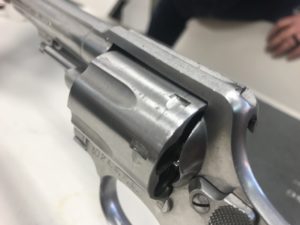
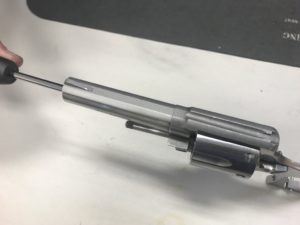
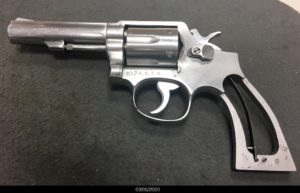
I also took the 1911 class. Ken covered all the testing processes to ensure proper operation of the 1911. After going over the lecture portion of the DF&R we went about checking our 1911’s we brought to class. I brought a particularly nice Colt 1991A1 a friend let me use for class. This gun was relatively new as far as rounds fired through it.It had a huge amount of loose breach and required repair. I contacted my friend and told him what was necessary and got the okie dokie. We TIG welded the hood and normalized it. Then the filing and fitting begins. Once done there was no loose breach and you couldn’t tell the work was done. Very satisfying. Also in the process we measured the chamber depth to determine if we had room to cut a full bevel to aid in feeding all the different cartridge and bullet types. (see photos) Ken also provided us with the measurements of the chamber gauges so we can fabricate our own.
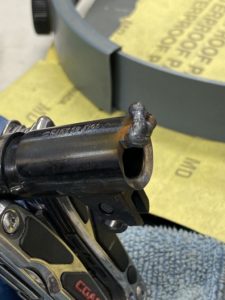
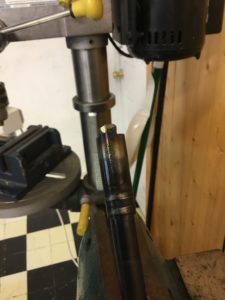
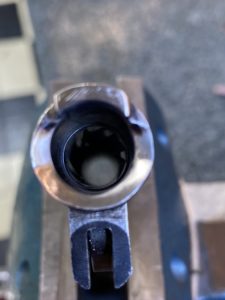
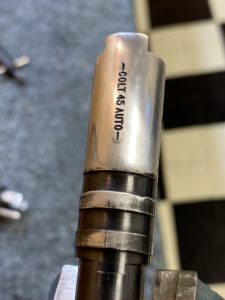
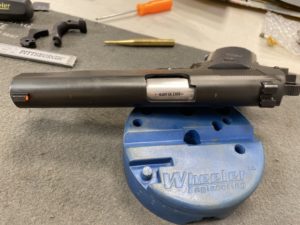
Troubleshooting class was next. Now in this class Ken does not need to do lecturing but, if you have questions or want him to cover anything specific you only need ask. The purpose of the class is to utilize your studies and what you learned from past classes and evaluate the guns you bring to see if the gun functions properly to determine if something is wrong and what you need to do to fix it. Then go about fixing it. I brought 14 handguns to the class and evaluated and fixed all of them before the week was done. The most interesting job was with my Walther PPK/S. Upon inspecting it I determined there was a problem with the extractor. When the case was on the bolt face the extractor was sitting too high which made it negative coupled with the fact that the loaded chamber indicator was sitting on the top of the case applying a downward pressure. This would also contribute to pushing the case off the bolt face.
I started by weakening the loaded chamber indicator spring enough so the indicator would still have enough pressure to return to its original position when the case is not in the gun. Next was to move the extractor down on the bolt face. We heated the extractor red and twisted downward. I filed it to fit in the slide then filed the proper extractor angles. Then it was a matter of the exterior of the extractor lining up with the slide so a bit more filing and fitting. Once done and the slide back on the gun I found that the new downward angle on the extractor was hitting the squared off slot for the extractor on the barrel. Now it was a matter of cutting a bevel to accept the extractor to allow the slide to close completely without binding.When all was done the case is now held in place by the extractor securely.
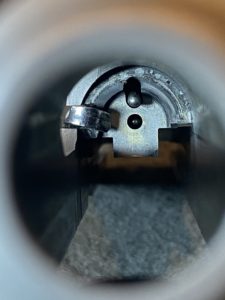
As you can see when you attend these classes you receive practical experience in making minor and major adjustments to the firearms including fabricating parts if one is not available for the gun you are working on. You do this using the gun as a template. Ken spends the time with you showing you how he makes the adjustment. But he tells you that if you have a better way to use it. He makes the class fun and a great learning experience. Some people in the class have different skill levels. We have had people with little experience to professional machinists. The one thing we all had in common was a willingness to learn and tons of questions.Ken accommodated all of us. I for one have enjoyed all the classes immensely and would recommend that you take advantage of the opportunity. I have also made many new friends that I keep in touch with regularly.
Ken loves teaching the classes and it shows. I am hoping for a COLT revolver class next year. I have found the classes to be very valuable and it has increased my confidence level to perform tough repairs in my shop. You will too.
Richard Macchia


 I also took the 1911 class. Ken covered all the testing processes to ensure proper operation of the 1911. After going over the lecture portion of the DF&R we went about checking our 1911’s we brought to class. I brought a particularly nice Colt 1991A1 a friend let me use for class. This gun was relatively new as far as rounds fired through it.It had a huge amount of loose breach and required repair. I contacted my friend and told him what was necessary and got the okie dokie. We TIG welded the hood and normalized it. Then the filing and fitting begins. Once done there was no loose breach and you couldn’t tell the work was done. Very satisfying. Also in the process we measured the chamber depth to determine if we had room to cut a full bevel to aid in feeding all the different cartridge and bullet types. (see photos) Ken also provided us with the measurements of the chamber gauges so we can fabricate our own.
I also took the 1911 class. Ken covered all the testing processes to ensure proper operation of the 1911. After going over the lecture portion of the DF&R we went about checking our 1911’s we brought to class. I brought a particularly nice Colt 1991A1 a friend let me use for class. This gun was relatively new as far as rounds fired through it.It had a huge amount of loose breach and required repair. I contacted my friend and told him what was necessary and got the okie dokie. We TIG welded the hood and normalized it. Then the filing and fitting begins. Once done there was no loose breach and you couldn’t tell the work was done. Very satisfying. Also in the process we measured the chamber depth to determine if we had room to cut a full bevel to aid in feeding all the different cartridge and bullet types. (see photos) Ken also provided us with the measurements of the chamber gauges so we can fabricate our own.




 Troubleshooting class was next. Now in this class Ken does not need to do lecturing but, if you have questions or want him to cover anything specific you only need ask. The purpose of the class is to utilize your studies and what you learned from past classes and evaluate the guns you bring to see if the gun functions properly to determine if something is wrong and what you need to do to fix it. Then go about fixing it. I brought 14 handguns to the class and evaluated and fixed all of them before the week was done. The most interesting job was with my Walther PPK/S. Upon inspecting it I determined there was a problem with the extractor. When the case was on the bolt face the extractor was sitting too high which made it negative coupled with the fact that the loaded chamber indicator was sitting on the top of the case applying a downward pressure. This would also contribute to pushing the case off the bolt face.
I started by weakening the loaded chamber indicator spring enough so the indicator would still have enough pressure to return to its original position when the case is not in the gun. Next was to move the extractor down on the bolt face. We heated the extractor red and twisted downward. I filed it to fit in the slide then filed the proper extractor angles. Then it was a matter of the exterior of the extractor lining up with the slide so a bit more filing and fitting. Once done and the slide back on the gun I found that the new downward angle on the extractor was hitting the squared off slot for the extractor on the barrel. Now it was a matter of cutting a bevel to accept the extractor to allow the slide to close completely without binding.When all was done the case is now held in place by the extractor securely.
Troubleshooting class was next. Now in this class Ken does not need to do lecturing but, if you have questions or want him to cover anything specific you only need ask. The purpose of the class is to utilize your studies and what you learned from past classes and evaluate the guns you bring to see if the gun functions properly to determine if something is wrong and what you need to do to fix it. Then go about fixing it. I brought 14 handguns to the class and evaluated and fixed all of them before the week was done. The most interesting job was with my Walther PPK/S. Upon inspecting it I determined there was a problem with the extractor. When the case was on the bolt face the extractor was sitting too high which made it negative coupled with the fact that the loaded chamber indicator was sitting on the top of the case applying a downward pressure. This would also contribute to pushing the case off the bolt face.
I started by weakening the loaded chamber indicator spring enough so the indicator would still have enough pressure to return to its original position when the case is not in the gun. Next was to move the extractor down on the bolt face. We heated the extractor red and twisted downward. I filed it to fit in the slide then filed the proper extractor angles. Then it was a matter of the exterior of the extractor lining up with the slide so a bit more filing and fitting. Once done and the slide back on the gun I found that the new downward angle on the extractor was hitting the squared off slot for the extractor on the barrel. Now it was a matter of cutting a bevel to accept the extractor to allow the slide to close completely without binding.When all was done the case is now held in place by the extractor securely.
 As you can see when you attend these classes you receive practical experience in making minor and major adjustments to the firearms including fabricating parts if one is not available for the gun you are working on. You do this using the gun as a template. Ken spends the time with you showing you how he makes the adjustment. But he tells you that if you have a better way to use it. He makes the class fun and a great learning experience. Some people in the class have different skill levels. We have had people with little experience to professional machinists. The one thing we all had in common was a willingness to learn and tons of questions.Ken accommodated all of us. I for one have enjoyed all the classes immensely and would recommend that you take advantage of the opportunity. I have also made many new friends that I keep in touch with regularly.
Ken loves teaching the classes and it shows. I am hoping for a COLT revolver class next year. I have found the classes to be very valuable and it has increased my confidence level to perform tough repairs in my shop. You will too.
Richard Macchia
As you can see when you attend these classes you receive practical experience in making minor and major adjustments to the firearms including fabricating parts if one is not available for the gun you are working on. You do this using the gun as a template. Ken spends the time with you showing you how he makes the adjustment. But he tells you that if you have a better way to use it. He makes the class fun and a great learning experience. Some people in the class have different skill levels. We have had people with little experience to professional machinists. The one thing we all had in common was a willingness to learn and tons of questions.Ken accommodated all of us. I for one have enjoyed all the classes immensely and would recommend that you take advantage of the opportunity. I have also made many new friends that I keep in touch with regularly.
Ken loves teaching the classes and it shows. I am hoping for a COLT revolver class next year. I have found the classes to be very valuable and it has increased my confidence level to perform tough repairs in my shop. You will too.
Richard Macchia